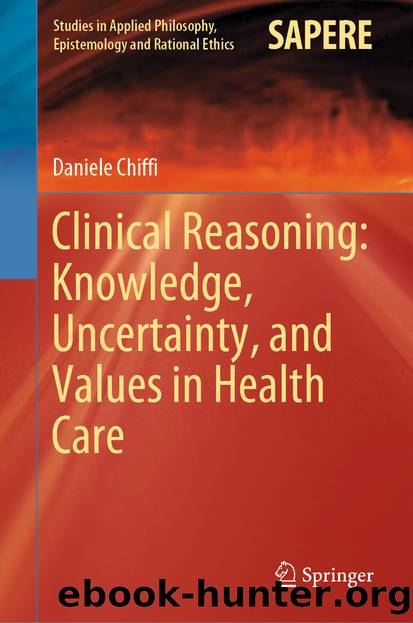Clinical Reasoning: Knowledge, Uncertainty, and Values in Health Care by Daniele Chiffi

Author:Daniele Chiffi
Language: eng
Format: epub
ISBN: 9783030590949
Publisher: Springer International Publishing
6.3 Clinical Possibility and Appropriateness
Beyond the internal and external validity of a clinical intervention, evidence for clinical practice needs to be clinically appropriate. Appropriateness evaluates interventions from the patientâs perspective. In fact, interventions are defined as appropriate when they are consistent with individualized aspects of care, based on the patientâs experiences, expectations and values (Shapiro 2010). Many patients receive inappropriate or unnecessary care, leading to an overuse or underuse of healthcare practices (Hicks 1994). There is therefore a need to propose methodological tools so as to determine the proper level of appropriateness for patients. Not all treatments which are both internally and externally valid are deemed appropriate when applied to a single clinical case. Likewise, some clinical possibilities holding at population level may not apply to a specific context. It seems however reasonable to assume that, in pragmatic studies, evidence is more likely to be shaped by different individual decisions rather than by experimental research.
I have pointed out that the notion of clinical possibility is involved in the diagnostic process. For instance, when making a differential diagnosis, it is important to take into account a finite and precise set of clinical possibilities so as to rule out those that express incorrect diagnostic hypotheses. At this stage, differential diagnosis may be used to isolate a specific clinical hypothesis, even if it was not present in the set of initial possibilities and there is no certainty as to whether it is the correct one. Alternatively, if evidence exists to positively confirm one of the initial hypotheses, then differential diagnosis may ascertain the presence of a specific disease, ruling out other possibilities (Federspil 2004).
Clinical possibilities may be positively supported by both a scintilla of evidence or the conflict with the epistemic and non-epistemic limitations mentioned above. Although possibilities which are positively confirmed by evidence are essential in the clinical context, in some limited cases even those possibilities not receiving direct and positive confirmation prove to be relevant to clinical practice. In fact, there may be complex situations in which bodily signs, morphological and laboratory examinations do not suffice to make a diagnosis. In such situations, the clinician may use the criterion of ex juvantibus, e.g. to choose a drug with a demonstrated effectiveness for a specific disease. If mitigation of signs appears or there is even healing, then the original diagnostic hypothesis may be confirmed. In other words, the ex juvantibus diagnostic criterion states that the observed beneficial effectiveness of a treatmentâif a diagnostic hypothesis has been formulatedâmay lead to a partial confirmation of the original hypothesis. Instead, if there was no diagnostic hypothesis at all, then the set of signs and symptoms would have to be resolved without any diagnosis. Thus, even those possibilities which are not directly supported by evidence may play a role in clinical practice, if they are actualised by some diagnostic method. In most cases, however, such a possibility of becoming actual (potentiality) is a distinctive feature of clinical possibility. I argue that potentiality is in fact connected with the teleological dimension of clinical knowledge.
Download
This site does not store any files on its server. We only index and link to content provided by other sites. Please contact the content providers to delete copyright contents if any and email us, we'll remove relevant links or contents immediately.
| Administration & Medicine Economics | Allied Health Professions |
| Basic Sciences | Dentistry |
| History | Medical Informatics |
| Medicine | Nursing |
| Pharmacology | Psychology |
| Research | Veterinary Medicine |
Periodization Training for Sports by Tudor Bompa(7895)
Why We Sleep: Unlocking the Power of Sleep and Dreams by Matthew Walker(6320)
Paper Towns by Green John(4765)
The Immortal Life of Henrietta Lacks by Rebecca Skloot(4233)
The Sports Rules Book by Human Kinetics(4057)
Dynamic Alignment Through Imagery by Eric Franklin(3897)
ACSM's Complete Guide to Fitness & Health by ACSM(3801)
Kaplan MCAT Organic Chemistry Review: Created for MCAT 2015 (Kaplan Test Prep) by Kaplan(3781)
Introduction to Kinesiology by Shirl J. Hoffman(3607)
Livewired by David Eagleman(3519)
The River of Consciousness by Oliver Sacks(3388)
The Death of the Heart by Elizabeth Bowen(3319)
Alchemy and Alchemists by C. J. S. Thompson(3280)
Descartes' Error by Antonio Damasio(3150)
Bad Pharma by Ben Goldacre(3074)
The Gene: An Intimate History by Siddhartha Mukherjee(2904)
The Emperor of All Maladies: A Biography of Cancer by Siddhartha Mukherjee(2890)
The Fate of Rome: Climate, Disease, and the End of an Empire (The Princeton History of the Ancient World) by Kyle Harper(2845)
Kaplan MCAT Behavioral Sciences Review: Created for MCAT 2015 (Kaplan Test Prep) by Kaplan(2794)
